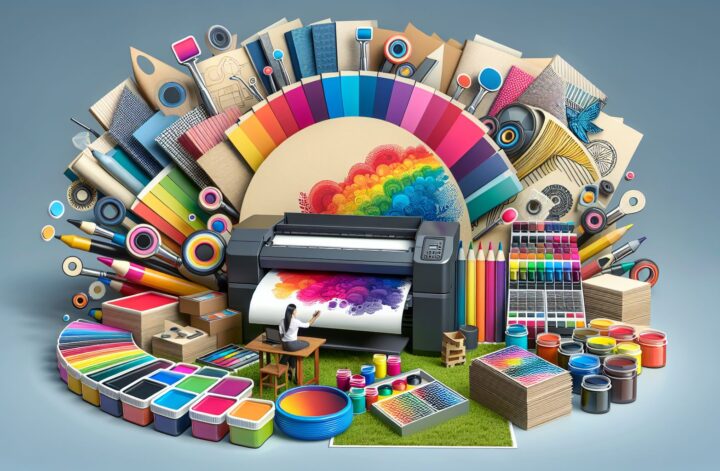When it comes to printing, there is so much more than meets the eye. Beyond the realm of ink and paper lies a vast array of printing materials that play a crucial role in the final output. Whether you’re a printing professional or simply curious about the subject, this comprehensive guide will introduce you to different printing materials, their properties, and their various applications. So, let’s dive deep into the world of printing materials!
Introduction
Printing materials encompass a wide range of substances used to create both functional and aesthetic printed products. These materials vary greatly in terms of texture, weight, thickness, and overall quality, allowing for different levels of durability, visual appeal, and versatility. Understanding the properties of different printing materials is essential to achieve desired outcomes, whether you’re printing business cards, posters, or creating fine art prints.
In this guide, we will take you through some of the most commonly used printing materials, discussing their characteristics, applications, and benefits. From paper to synthetic substrates, let’s explore the diverse world of printing materials.
The Basics of Paper
Paper is the most fundamental and widely used printing material. It is composed of cellulose fibers derived from various plant sources, such as wood pulp, cotton, or recycled materials. Paper comes in an assortment of weights, commonly measured in grams per square meter (gsm), and finishes, ranging from uncoated to glossy.
Uncoated Paper
Uncoated paper is porous, allowing the ink to absorb and dry quickly. It typically results in a more natural, textured finish since the ink penetrates into the paper fibers. Due to its absorbency, uncoated paper is often used for products such as business stationery, books, and newspapers.
Coated Paper
Unlike uncoated paper, coated paper has a smooth, glossy surface. This type of paper is coated with a thin layer of clay or other substances, making it less absorbent. The coating prevents the ink from spreading and provides sharp, vibrant colors with excellent image clarity. Coated paper is commonly used for high-quality, full-color prints, such as magazines, brochures, and photography portfolios.
Cardstock
Cardstock, also known as cover stock or pasteboard, is a heavyweight paper variant. It is sturdier and thicker than standard paper, making it a fantastic choice for products requiring extra durability, like business cards, postcards, and packaging materials. Cardstock comes in various thicknesses, typically measured in points or mils.
Synthetic Substrates: Beyond Paper
While paper is the go-to choice for many printing needs, there are times when synthetic substrates offer unique advantages. Synthetic substrates are materials manufactured using chemical processes to create surfaces suitable for printing. They often possess traits that paper lacks, such as moisture resistance, tear resistance, and UV stability. Let’s explore a few popular ones!
Vinyl
Vinyl is a synthetic material that offers remarkable versatility and durability. It is commonly used for large-format printing applications such as banners, signs, and vehicle wraps. Vinyl can withstand harsh weather conditions, making it ideal for outdoor advertising. It comes in various finishes, including matte, gloss, and semi-gloss, offering designers a wide range of creative possibilities.
Polyester Film
Polyester film is a transparent or translucent material that can withstand both high and low temperatures. It is commonly used in applications like overhead projection sheets and backlit displays. With excellent dimensional stability and resistance to tearing, polyester film grants exceptional clarity and crispness to printed images, ensuring optimal visual impact.
Polypropylene
Polypropylene, often abbreviated as PP, is a lightweight synthetic material known for its flexibility and resistance to moisture. Due to its durability, it finds use in a wide range of products, including labels, stickers, point-of-sale displays, and packaging. Polypropylene is also a popular choice for printing materials that require prolonged outdoor exposure, as it maintains color vibrancy even under challenging environmental conditions.
Canvas
Canvas is a woven fabric made traditionally from cotton, although polyester blends are also common. It is widely used for fine art reproduction and printing photographs, providing an elegant and artistic texture to the final product. Canvas prints offer a unique visual appeal, simulating the look and feel of an original painting.
Conclusion
Printing materials form the backbone of the printing industry. From the ever-present paper to the versatile synthetic substrates, understanding the characteristics and applications of various printing materials is crucial for achieving exceptional results. Whether you’re a professional printer or someone looking to explore the possibilities of printing, this comprehensive guide has provided you with a solid foundation.
Remember, selecting the right printing material for your project involves considering factors like durability, desired aesthetics, and intended use. So, the next time you embark on a printing venture, take a moment to explore the vast world of printing materials and choose wisely to bring your prints to life!


